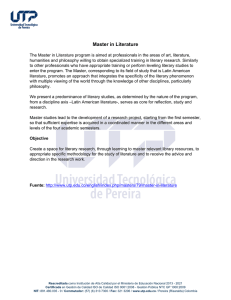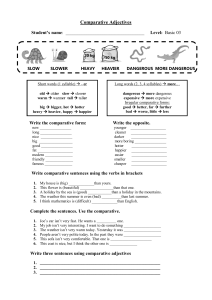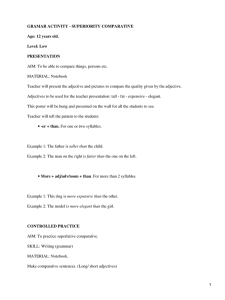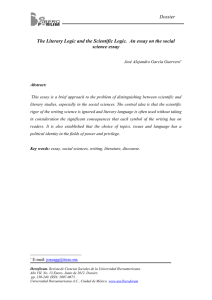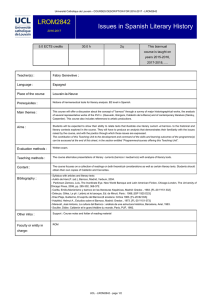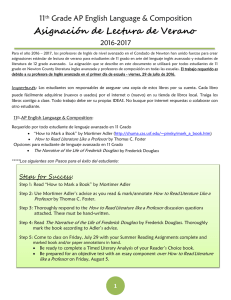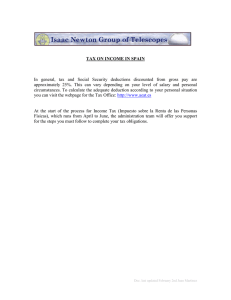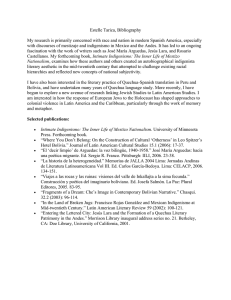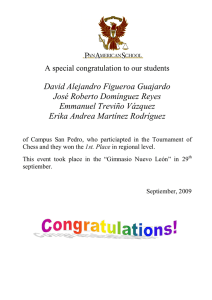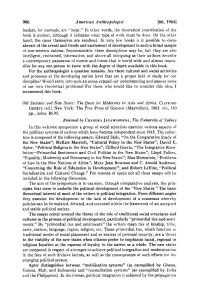286 Revista Alicantina de Estudios Ingleses his daughter
Anuncio
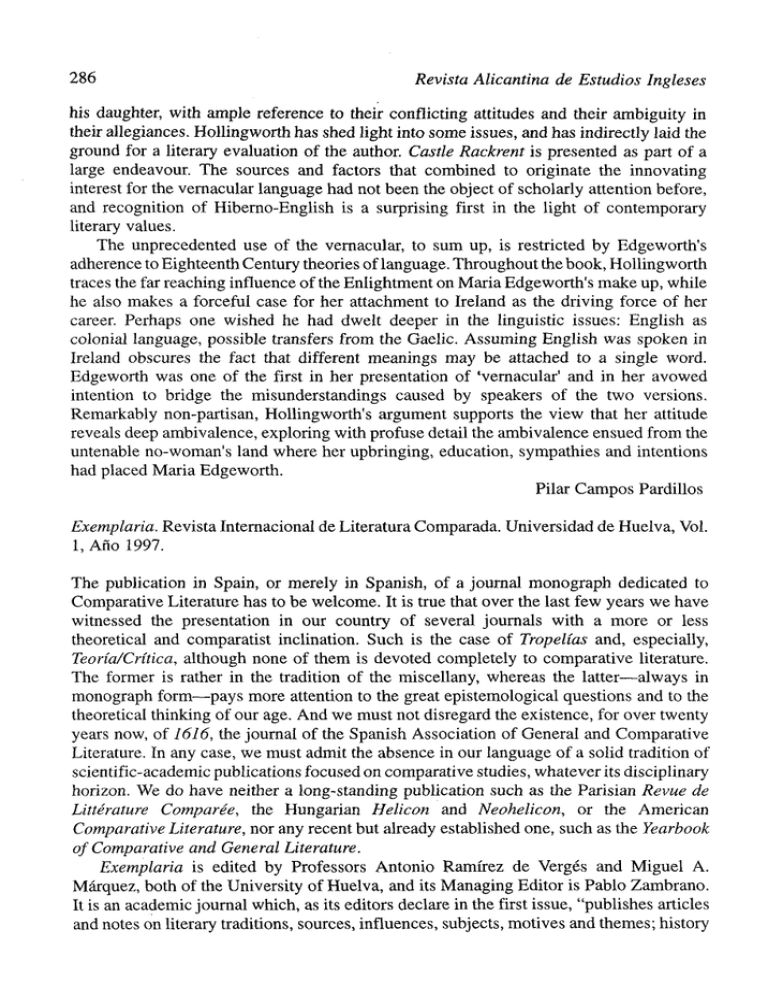
286 Revista Alicantina de Estudios Ingleses his daughter, with ampie reference to their conflicting attitudes and their ambiguity in their allegiances. Hollingworth has shed light into some issues, and has indirectly laid the ground for a literary evaluation of the author. Castle Rackrent is presented as part of a large endeavour. The sources and factors that combined to origínate the innovating interest for the vernacular language had not been the object of scholarly attention before, and recognition of Hiberno-English is a surprising first in the light of contemporary literary valúes. The unprecedented use of the vernacular, to sum up, is restricted by Edgeworth's adherence to Eighteenth Century theories of language. Throughout thebook, Hollingworth traces the far reaching influence of the Enlightment on Maria Edgeworth's make up, while he also makes a forceful case for her attachment to Ireland as the driving forcé of her career. Perhaps one wished he had dwelt deeper in the linguistic issues: English as colonial language, possible transfers from the Gaelic. Assuming English was spoken in Ireland obscures the fact that different meanings may be attached to a single word. Edgeworth was one of the first in her presentation of 'vernacular' and in her avowed intention to bridge the misunderstandings caused by speakers of the two versions. Remarkably non-partisan, Hollingworth's argument supports the view that her attitude reveáis deep ambivalence, exploring with profuse detail the ambivalence ensued from the untenable no-woman's land where her upbringing, education, sympathies and intentions had placed Maria Edgeworth. Pilar Campos Pardillos Exemplaria. Revista Internacional de Literatura Comparada. Universidad de Huelva, Vol. 1, Año 1997. The publication in Spain, or merely in Spanish, of a journal monograph dedicated to Comparative Literature has to be welcome. It is true that over the last few years we have witnessed the presentation in our country of several journals with a more or less theoretical and comparatist inclination. Such is the case of Tropelías and, especially, Teoría/Crítica, although none of them is devoted completely to comparative literature. The former is rather in the tradition of the miscellany, whereas the latter—always in monograph form—pays more attention to the great epistemological questions and to the theoretical thinking of our age. And we must not disregard the existence, for over twenty years now, of 1616, the journal of the Spanish Association of General and Comparative Literature. In any case, we must admit the absence in our language of a solid tradition of scientific-academic publications focused on comparative studies, whatever its disciplinar/ horizon. We do have neither a long-standing publication such as the Parisian Revue de Littérature Comparée, the Hungarian Helicón and Neohelicon, or the American Comparative Literature, ñor any recent but already established one, such as the Yearbook of Comparative and General Literature. Exemplaria is edited by Professors Antonio Ramírez de Vergés and Miguel A. Márquez, both of the University of Huelva, and its Managing Editor is Pablo Zambrano. It is an academic journal which, as its editors declare in the first issue, "publishes articles and notes on literary traditions, sources, influences, subjects, motives and themes; history Reviews 287 of the literary genres; relationships among authors; all of it within the context of Western literature. Only occasionally, so long as the contribution is especially relevant, do we publish essays on literary periods, international relationships and literary theory". This declaration, scarcely comparatist and definitely unpretentious, may sound too restrictive; but the authors do not intend to cover an extensive field of comparatism and theory, as is the case of the aforementioned Yearbook. Exemplaria contains three sections: articles, notes and reviews. The first section of the first issue includes ten articles. The first one, Pierre Bruynel, is a reflection on the concepts of theme and myth as exemplified by the figure of the labyrinth. This first issue also collects essays by Francisco Abad (on comparative studies in Menéndez Pidal's school), Vicente Cristóbal (on Anaxarete from Ovid to Jorge Guillen), Susana Gil Albarellos (on the Renaissance debates about chivalry), Antonio Garnica (on the Spanish anticlerical novel), Eloisa Nos Aldas (on Hugh MacDiarmid and Emily Dickinson), Luis Gómez Canseco (on mythical and archetypal structures in Sánchez Mazas' novéis), Carmen Pérez Romero and Lourdes Nuevo (on the functions of the proper ñame in the shaping of character), Luisa María Gutiérrez Hermosa (on the theory of the Golden Age novella), and José Enrique Martínez Fernández (on literary influence and textual marks). As to the "Notes" section, this first issue of Exemplaria contains contributions by Miguel A. Márquez (on variations of the carpe diem topic in Propertius), Montserrat Martínez Vázquez (on a sonnet by Philip Sidney), Zenón Luis Martínez (on Román caritas in King Lear), and Pablo Zambrano (on John Donne and Ovid's Amori). The rest is complete with excellent reviews of such recent books as D. Blow's Mirabile Dictu: Representations ofthe Marvelous in Medieval and Renaissance Epic (Ann Arbor, 1996), G. A. Kennedy's A New History of Classical Rhetoric (Princeton, 1994), J. Álvarez Barrientes and J. Checa Beltrán's El siglo que llaman ilustrado (Madrid, 1996), M. Alloin-Castrillo's Paul Valéry y el mundo hispánico (Madrid, 1995), G. Steiner's No Passion Spent: Essays, 1978-1995 (New Haven, 1996), and P. H. Pinero Ramírez's edited collection Descensus ad infernos. La aventura de ultratumba de los héroes (de Homero a Goethe) (Sevilla, 1996). Finally, we must note that all the articles and notes in this issue are published in either Spanish, French or English. We must understand that future issues will contain essays in other languages as well. Francisca Vázquez Ramón Ribé (with the collaboration of María Luz Celaya, Margarita Ravera, Fernanda Rodríguez, Elsa Tragant y Nuria Vidal). Tramas creativas y aprendizaje de lenguas (Prototipos de tareas de tercera generación), Barcelona, Universitat de Barcelona, Publicacions, 1997, 306 pp. The book reviewed here represents, above all, a very interesting and relevant contribution in the complex but equally attractive world of foreign language teaching. The author and his colleagues have succeeded in presenting an exhaustive working corpus which, as I will
